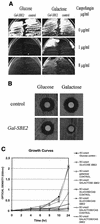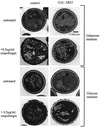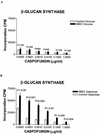Overexpression of Sbe2p, a Golgi protein, results in resistance to caspofungin in Saccharomyces cerevisiae
- PMID: 12121919
- PMCID: PMC127366
- DOI: 10.1128/AAC.46.8.2462-2469.2002
Overexpression of Sbe2p, a Golgi protein, results in resistance to caspofungin in Saccharomyces cerevisiae
Abstract
Caspofungin inhibits the synthesis of 1, 3-beta-D-glucan, an essential cell wall target in fungi. Genetic studies in the model yeast Saccharomyces cerevisiae have shown that mutations in FKS1 and FKS2 genes result in caspofungin resistance. However, direct demonstration of the role of gene overexpression in caspofungin resistance has been lacking. We transformed wild-type S. cerevisiae with an S. cerevisiae URA3-based GAL1 cDNA library and selected transformants in glucose synthetic complete plates lacking uracil (glucose SC minus uracil plates). We then moved the transformants to galactose SC minus uracil plates containing caspofungin (1 microg/ml) and looked for caspofungin-resistant colonies. We retested the candidates (true positives were sensitive on glucose caspofungin and resistant on galactose caspofungin media, respectively). We identified 16 caspofungin-resistant candidates. Restriction analysis and hybridization confirmed that 15 of the 16 clones were identical. We sequenced one of the cDNA clones and found that it contained the cDNA for SBE2. SBE2 has been described in S. cerevisiae to encode a Golgi protein involved in the transport of cell wall components (B. Santos and M. Snyder, Mol. Biol. Cell, 11:435-452, 2000). The SBE2 cDNA plasmid conferred again galactose-dependent caspofungin resistance when transformed back into the wild-type S. cerevisiae. Finally, the SBE2 deletion mutant was hypersensitive to caspofungin. In conclusion, overexpression of Sbe2p under the regulated control of the GAL1 promoter results in caspofungin resistance in S. cerevisiae. This transport pathway may provide insight into the tolerance or lack of sensitivity to caspofungin of some pathogenic fungi.
Figures




References
-
- Abe, M., I. Nishida, M. Minemura, H. Qadota, Y. Seyama, T. Watanabe, and Y Ohya. 2001. Yeast 1,3-β-glucan synthase activity is inhibited by phytosphingosine localized to the endoplasmic reticulum. J. Biol. Chem. 276:26923-26930. - PubMed
-
- Ausubel, F. M., R. Brent, R. E. Kingston, D. D. Moore, J. G. Seidman, J. A. Smith, and K. Struhl (ed.). 1998. Current protocols in molecular biology. Greene Publishing Associates/Wiley Inter Science, New York, N.Y..
Publication types
MeSH terms
Substances
Grants and funding
LinkOut - more resources
Full Text Sources
Medical
Molecular Biology Databases
Research Materials

